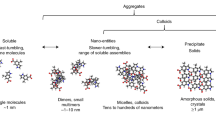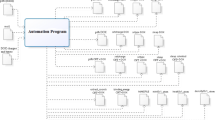Abstract
The self-assembly of non-toxic well-consumed small caffeine molecules into well-defined structures has important implications for future medical applications seeking to target the transport of small drugs in human body. Particularly, the solvation of the microenvironments of the self assembly ultimately dictates the interaction with the drug molecules and their therapeutic efficacy. We present femtosecond-resolved studies of the dynamics of aqueous solvation within self-assembled dimeric structure of caffeine molecules. We have placed small hydrophobic probes 4-(dicyanomethylene)-2-methyl-6-(p-dimethylaminostyryl) 4H-pyran (DCM), coumarin 500 (C500) into the caffeine dimer to enable spectroscopic examinations of the interior. While molecular modeling and NMR studies of the probes in the caffeine dimers reveal a well-defined location (stacked in between two caffeine molecules), dynamical light scattering (DLS), Fourier transform infrared (FTIR) spectroscopy, densimetric and sonometric experiments explore the structural evolution of the dimer upon complexation with the probes. We have extended our studies in various temperatures in order to explore structural evolution of the self assembled structure and consequently the dynamics of solvation in the interior of the dimer. Picoseconds/femtosecond resolved dynamics and the polarization gated spectroscopic studies unravel the hydration and energetics associated with activated viscous flow of the confined probes. Our studies indicate that the interior of the caffeine dimer is well-solvated; however, the dynamics of solvation is retarted significantly compared to that in bulk water, clearly revealing the dimers maintain some ordered water molecules. We have also explored the consequence of the retarded dynamics of solvation on the photo-induced electron transfer (ET) reaction of a model probe, 2-(p-toluidino) naphthalene-6-sulfonate (TNS) encapsulated in the dimer.











Similar content being viewed by others
References
Selby CP, Sancar A (1990) Molecular mechanisms of DNA repair inhibition by caffeine. Proc Natl Acad Sci 87:3522–3525
Larsen RW, Jasuja R, Hetzler RK, Muraoka PT, Andrada VG, Jameson DM (1996) Spectroscopic and molecular modeling studies of caffeine complexes with DNA intercalators. Biophys J 70:443–452
Davies DB, Veselkov DA, Djimant LN, Veselkov AN (2001) Heteroassociation of caffeine and aromatic drugs and their competitive binding with a DNA oligomer. Eur Biophys J 30:354–366
McKelvey VJ, McKenna PG (1986) Enhanced synergism between caffeine and mitomycin C in the induction of cytogenetic aberrations in thymidine kinase-deficient Friend murine erythroleukaemia cells. Mutagenesis 1:173–178
Mourelatos D, Dozi-Vassiliades J, Kotsis A, Gourtsas C (1988) Enhancement of cytogenetic damage and of antineoplastic effect by caffeine in Ehrlich Ascites tumor cells treated with cyclophosphamide in vivo. Cancer Res 48:1129–1131
Andersson HC, Kihlman BA (1987) Effects of G2 treatments with inhibitors of DNA synthesis and repair on chromosome damage induced by X-rays and chemical clastogens in root tips of Vicia faba comparison with corresponding effects in cultured human lymphocytes. Mutat Res 181:173–185
Ross WE, Zwelling LA, Kohn KW (1979) Relationship between cytotoxicity and dna strand break-age produced by adriamycin and other intercalating agents. Int J Radiat Oncol Biol Phys 5:1221–1224
Iliakis G, Nusse M, Ganapathi R, Egner I, Yen A (1986) Differential reduction by caffeine of adriamycin induced cell killing and cell cycle delays in chinese hamster v79 cells. Int J Radiat Oncul Biol Phys 12:1987–1995
Ganapathi R, Grabowski D, Schmidt H, Yen A, Iliakis G (1986) Modulation of adriamycin and N-Trifluoroacetyladriamycin-14-valerate induced effects on cell cycle traverse and cytotoxicity in P388 mouse leukemia cells by caffeine and the calmodulin inhibitor trifluoperazine. Cancer Res 46:5553–5557
Kimura H, Aoyama T (1989) Decrease in sensitivity to ethidium bromide by caffeine, dimethylsulfoxide or 3-aminobenzamide due to reduced permeability. J Pharmacobio-Dyn 12:589–595
Traganos F, Kaminska-Eddy B, Darzynkiewicz Z (1991) Caffeine reverses the cytotoxic and cell kinetic effects of Novantrone (mitoxantrone). Cell Prolif 24:305–319
Johansson B, Halldner L, Dunwiddie TV, Masino SA, Poelchen W, Llort LG, Escorihuela RM, Teruel AF, Hallin ZW, Xu XJ, Hårdemark A, Betsholtz C, Herlenius E, Fredholm BB (2001) Hyperalgesia, anxiety, and decreased hypoxic neuroprotection in mice lacking the adenosine A1 receptor. Proc Natl Acad Sci 98:9407–9412
Vajda S, Jimenez R, Rosenthal SJ, Fidlert V, Fleming GR, Castner EW Jr (1995) Femtosecond to nanosecond solvation dynamics in pure water and inside the y-cyclodextrin cavity. J Chem Soc Faraday Trans 91:867–873
Danilov VI, Shestopalova AV (1989) Hydrophobic effect in biological associates: a monte carlo simulation of caffeine molecules stacking. Int J Quantum Chem 35:103–112
Falk M, Chew W, Walter JA, Kwiatkowski W, Barclay KD, Klassen GA (1998) Molecular modelling and NMR studies of the caffeine dimer. Can J Chem 76:48–56
Kalugin MD, Teplukhin AV (2009) Study of caffeine–DNA interaction in aqueous solution by Parallel Monte Carlo simulation. J Struct Chem 50:841–852
Wong ELS, Gooding JJ (2007) The electrochemical monitoring of the perturbation of charge transfer through DNA by Cisplatin. J Am Chem Soc 129:8950–8951
Řeha D, Kabelá M, Ryjáek F, Šponer J, Šponer JE, Elstner M, Suhai S, Hobza P (2002) Intercalators. 1. Nature of stacking interactions between intercalators (Ethidium, Daunomycin, Ellipticine, and 4’,6-Diaminide-2-phenylindole) and DNA base pairs. Ab initio quantum chemical, density functional theory, and empirical potential study. J Am Chem Soc 124:3366–3376
Maroncelli M, MacInnis J, Fleming GR (1989) Polar solvent dynamics and electron-transfer reactions. Science 243:1674–1681
Rips I, Jortner J (1987) Dynamic solvent effects on outer–sphere electron transfer. J Chem Phys 87:2090–2104
Hynes JT (1986) Outer-sphere electron-transfer reactions and frequency-dependent friction. J Phys Chem 90:3701–3706
Cesaro A, Russo E, Crescenzl V (1976) Thermodynamics of caffeine aqueous solutions. J Phys Chem 80:335–339
Bismuto E, Sirangelo I, Adinolfi A, Gaetano Irace G (1990) Dynamic fluorescence of extrinsic fluorophores as a tool for studying protein conformational substates. Biol Metals 3:131–132
Sitkowski J, Stefaniak L, Nicol L, Martin ML, Martin GJ, Webb GA (1995) Complete assignments of the 1H, 13C and 15N NMR spectra of caffeine. Spectrochim Acta A Mol Biomol Spectrosc 51:839–841
Banerjee D, Verma PK, Pal SK (2009) Temperature-dependent femtosecond-resolved hydration dynamics of water in aqueous guanidinium hydrochloride solution. Photochem Photobiol Sci 8:1441–1447
Carlucci L, Gavezzotti A (2005) Molecular recognition and crystal energy landscapes: an X-ray and computational study of caffeine and other methylxanthines. Chem Eur J 11:271–279
Jahagirdar DV, Arbad BR, Walvekar AA, Shankarwar AG, Lande MK (2000) Studies in partial molar volumes, partial molar compressibilities and viscosity B-coefficients of caffeine in water at four temperatures. J Mol Liq 85:361–373
Maevsky AA, Sukhorukov BI (1980) IR study of base stacking interactions. Nucl Acids Res 8:3029–3042
Falk M, Gil M, Iza N (1990) Self-association of caffeine in aqueous solution: an FT-IR study. Can J Chem 68:1293–1299
Millero FJ, Surdo AL, Shin C (1978) The apparent molal volumes and adiabatic compressibilities of aqueous amino acids at 25.degree.C. J Phys Chem 82:784–792
Benz R (1961) Some thermodynamic properties of the system PuCl3—KCl from electromotive force data. J Phys Chem 65:81–84
Bockris JOM, Saluja PPS (1972) Ionic solvation numbers from compressibilities and ionic vibration potentials measurements. J Phys Chem 76:2140–2151
Hirata F, Arakawa K (1972) Ultrasonic study of solute-solvent interaction in aqueous solutions of Tetraalkylammonium salts. Bull Chem Soc Jpn 45:2715–2719
Pal SK, Sukul D, Mandal D, Sen S, Bhattacharyya K (2000) Solvation dynamics of DCM in micelles. Chem Phys Lett 327:91–96
Sarkar R, Shaw AK, Ghosh M, Pal SK (2006) Ultrafast photoinduced deligation and ligation dynamics: DCM in micelle and micelle-enzyme complex. J Photochem Photobiol B 83:213–222
Pal SK, Mandal D, Sukul D, Bhattacharyya K (1999) Solvation dynamics of 4-(dicyanomethylene)-2-methyl-6-(p-dimethylaminostyryl)-4H-pyran (DCM) in a microemulsion. Chem Phys Lett 312:178–184
Meyer M, Mialocq JC (1987) Ground state and singlet excited state of laser dye DCM: Dipole moments and solvent induced spectral shift. Opt Commun 64:264–268
Meuler PVD, Zhang H, Jonkman AM, Glasbeek M (1996) Subpicosecond solvation relaxation of 4-(Dicyanomethylene)-2-methyl-6-(p-(dimethylamino)styryl)-4H-pyran in polar liquids. J Phys Chem 100:5367–5373
Drake JM, Lesiecki ML, Camaioni DM (1985) Photophysics and Cis_Trans Isomerization of DCM. Chem Phys Lett 113:530–534
Zhang H, Jonkman AM, Pvd M, Glasbeek M (1994) Femtosecond studies of charge separation in photo-excited DCM in liquid solution. Chem Phys Lett 224:551–556
Easter DC, Baronavski AP (1993) Ultrafast relaxation in the fluorescent state of the laser dye DCM. Chem Phys Lett 201:153–158
Philips LA, Webb SP, Clark JH (1985) High-pressure studies of rotational reorientation dynamics: the role of dielectric friction. J Chem Phys 83:5810–5821
Kalman B, Clarke N, Johansson LBA (1989) Dynamics of a new fluorescent probe, 2,5,8,11-tetra-tert-butylperylene in solution, cubic lyotropic liquid crystals, and model membranes. J Phys Chem 93:4608–4615
Zana R (1999) Microviscosity of aqueous surfactant micelles: effect of various parameters. J Phys Chem B 103:9117–9125
Fee RS, Maroncelli M (1994) Estimating the time-zero spectrum in time-resolved emmsion measurements of solvation dynamics. Chem Phys 183:235–247
Jimenez R, Fleming GR, Kumar PV, Maroncelli M (1994) Femtosecond solvation dynamics of water. Nature 369:471–473
Riter RE, Willard DW, Levinger NE (1998) Water immobilization at surfactant interfaces in reverse micelles. J Phys Chem B 102:2705–2714
Corbeil EM, Levinger NE (2003) Dynamics of polar solvation in quaternary microemulsions. Langmuir 19:7264–7270
Zhong D, Pal SK, Zewail AH (2001) Femtosecond studies of protein -DNA binding and dynamics: Histone I. Chem Phys Chem 2:219–227
Hirose K (2001) A practical guide for the determination of binding constants. J Incl Phenom Macrocycl Chem 39:193–209
Datta A, Mandal D, Pal SK, Das S, Bhattacharyya K (1998) Interaction of triton X-100 with cyclodextrins. A fluorescence study. J Chem Soc Faraday Trans 94:3471–3475
Chang TL, Cheung HC (1990) A model for molecules with twisted intramolecular charge transfer characteristics: solvent polarity effect on the nonradiative rates of dyes in a series of water—ethanol mixed solvents. Chem Phys Lett 173:343–348
Bhattacharyya K, Chowdhury M (1993) Environmental and magnetic field effects on exciplex and twisted charge transfer emission. Chem Rev 93:507–535
Sarkar N, Das K, Nath D, Bhattacharyya K (1992) Interaction of urea with fluorophores bound to cyclodextrins. Fluorescence of p-toluidino naphthalene sulphonate. Chem Phys Lett 196:491–496
Nakamura A, Saitoh K, Toda F (1991) Fluctuation in structure of inclusion complexes of cyclodextrins with fluorescent probes. Chem Phys Lett 187:110–115
Sarkar N, Das K, Nath D, Bhattacharyya K (1994) Salt effect on the hydrophobic binding of p-toluidino naphthalene sulphonate with cyclodextrins. Chem Phys Lett 218:492–498
Almgren M, Grieser F, Thomas JK (1979) Dynamic and static aspects of solubilization of neutral arenes in ionic micellar solutions. J Am Chem Soc 101:279–291
Jobe DJ, Verrall RE, Palepu R, Reinsborough VC (1988) Fluorescence and conductometric studies of potassium 2-(p-Toluidinyl)naphthalene-6-sulfonate/Cyclodextrin/Surfactant systems. J Phys Chem 92:3582–3586
Catena GC, Bright FV (1989) Thermodynamic study on the effects of P-cyclodextrin inclusion with anilinonaphthalenesulfonates. Anal Chem 61:905–909
Sen P, Mukherjee S, Halder A, Bhattacharyya K (2004) Temperature dependence of solvation dynamics in a micelle. 4-Aminophthalimide in Triton X-100. Chem Phys Lett 385:357–361
Acknowledgements
S.B. thanks UGC and P.K.V. thanks CSIR for Research Fellowships. We thank DST for a financial grant (SR/SO/BB-15/2007). We extend our thanks to Barun Majumder for helping us to carry out the NMR experiments.
Author information
Authors and Affiliations
Corresponding author
Electronic supplementary material
Below is the link to the electronic supplementary material.
ESM 1
(DOC 83 kb)
Rights and permissions
About this article
Cite this article
Banerjee, S., Verma, P.K., Mitra, R.K. et al. Probing the Interior of Self-Assembled Caffeine Dimer at Various Temperatures. J Fluoresc 22, 753–769 (2012). https://doi.org/10.1007/s10895-011-1011-3
Received:
Accepted:
Published:
Issue Date:
DOI: https://doi.org/10.1007/s10895-011-1011-3




